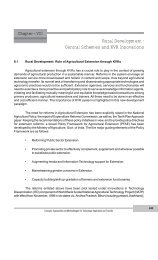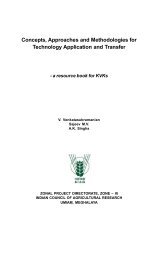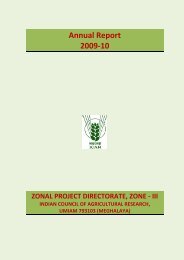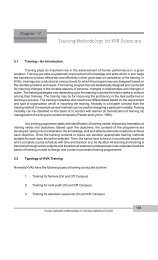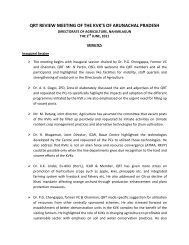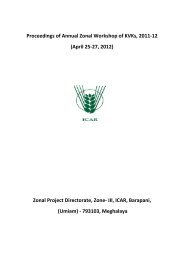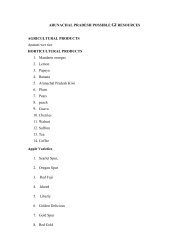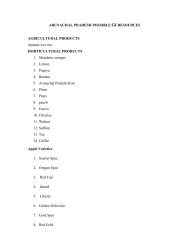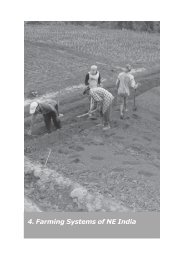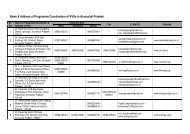Sajeev M.V, V. Venkatasubramanian & A.K. SinghaThe inclusion of the non-farming community, i.e taking a territorial rather than a sectoralapproach. This is all the more important in Europe, where a large share of family farmerswork part-time and include off-farm employment in their strategy for survival. Some authorstherefore prefer the term ‘rural systems’ or ‘regional systems’ over ‘farming systems’.System performance is no longer limited to productivity, but includes stability andsustainability. In other words, with the understanding of systems as being dynamic, the timeframe under consideration has been lengthened. Since the late 1990s change dynamicsincreasingly have become a topic of research, addressing a variety of dimensions: farmhousehold composition, farmer’s goals and preferences, markets and institutions. This impliesnew constraints as well as new opportunities and thus different system dynamics. Moreover,integrated assessment methods related to the three pillars of sustainable development needto be developed.With the realisation that farms change continuously to co-evolve with their social, economicand ecological contexts, the search for an ‘ideal’ or ‘best bet’ innovation was dropped. Dynamicconditions call for ‘learning by doing’. Learning is not considered a passive process of teachingor transferring information to farmers, but rather as an active and on-going process of testingand acquiring new insights.The contribution of agricultural growth to poverty alleviationThe evidence is quite clear that broad-based agricultural development provides an effective meansfor both reducing poverty and accelerating economic growth. This is normally achieved not only byincreasing incomes for producers and farm workers, but also by creating demand for non-tradablegoods - namely services and local products. It is this indirect effect on demand, and the associatedemployment creation in the off-farm sector of rural areas and market towns, that appears to be themain contributing factor to the reduction of rural poverty. Furthermore, as other studies show (Dattand Ravallion, 1998), agricultural growth can reduce urban poverty more rapidly than does urbangrowth itself, largely because of the consequent reduction in urban food costs and lower rates of inmigrationfrom rural areas. The evidence is overwhelming that it is essential to accelerate agriculturalgrowth if poverty is to decline rapidly (Mellor, 2000).While overall agricultural growth is undoubtedly an effective engine for economic development andpoverty reduction, the form that this growth takes has a bearing on its effectiveness in reducingrural poverty. Thus, rising productivity within labour-intensive small farms, which generates extrademand for local goods and services, can be expected to have a broader effect on poverty reductionthan equivalent productivity increases on large, mechanized holdings, which typically generate lessadditional demand for local goods and services.<strong>Farming</strong> <strong>Systems</strong> of North East India5
Sajeev M.V, V. Venkatasubramanian & A.K. SinghaThe challenge for developing countries is to identify specific agricultural and rural development needsand opportunities, and to focus investment in areas where the greatest impact on food insecurity andpoverty will be achieved. This identification and resource allocation process can be facilitated by analyzingfarming systems in order to develop an understanding of local factors and linkages. In the course of thisanalytical process it is also extremely helpful to be able to aggregate locations with similar developmentconstraints and investment opportunities through the application of a farming systems framework.The concept of farming systemsFarmers typically view their farms, whether small subsistence units or large corporations, as systems intheir own right. The following systems diagram (see Figure 1) of a typical farm system, drawn byBangladeshi farmers, illustrates the structural complexity and interrelationships between variouscomponents of a smallholding. It also shows the variety of natural resources available to farm families.These resources normally include different types of land, various water sources and access to commonproperty resources - including ponds, grazing areas and forest. To these basic natural resources may beadded climate and biodiversity, as well as human, social and financial capital. The diagram also illustratesthe diversity which characterizes the livelihoods of most smallholders.Each individual farm has its own specific characteristics arising from variations in resource endowmentsand family circumstances. The household, its resources, and the resource flows and interactions at thisindividual farm level are together referred to as a farm system (Dillon et al 1978, Shaner et al 1982,Norman et al 1982). The biophysical, socio-economic and human elements of a farm are interdependent,and thus farms can be analyzed as systems from various points of view.Figure 1 Farmers’ View of a Farm System, Bangladesh (Lightfoot et al 1991)6<strong>Farming</strong> <strong>Systems</strong> of North East India
- Page 3 and 4: We sincerely acknowledge theconstan
- Page 5 and 6: PREFACEFarming System Research/Exte
- Page 7 and 8: 2. Methodology2.1.0 Selection of Di
- Page 9 and 10: 4.2.3 Farming Systems of Darrang 41
- Page 11 and 12: 5.3.3 Research priorities and strat
- Page 13 and 14: 6.6 Development strategies for Naga
- Page 15 and 16: Blank Page
- Page 17 and 18: Sajeev M.V, V. Venkatasubramanian &
- Page 19: Sajeev M.V, V. Venkatasubramanian &
- Page 23 and 24: Sajeev M.V, V. Venkatasubramanian &
- Page 25 and 26: Sajeev M.V, V. Venkatasubramanian &
- Page 27 and 28: Sajeev M.V, V. Venkatasubramanian &
- Page 29 and 30: Sajeev M.V, V. Venkatasubramanian &
- Page 31 and 32: Sajeev M.V, V. Venkatasubramanian &
- Page 33 and 34: Sajeev M.V, V. Venkatasubramanian &
- Page 35 and 36: Sajeev M.V, V. Venkatasubramanian &
- Page 37 and 38: Sajeev M.V, V. Venkatasubramanian &
- Page 39 and 40: Sajeev M.V, V. Venkatasubramanian &
- Page 41 and 42: Sajeev M.V, V. Venkatasubramanian &
- Page 43 and 44: Sajeev M.V, V. Venkatasubramanian &
- Page 45: Sajeev M.V, V. Venkatasubramanian &



